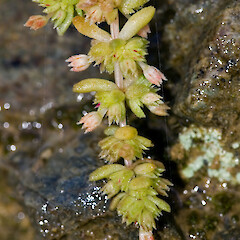Crassula sieberiana
Synonyms
Tillaea sieberiana Schultes et Schultes.f.
Family
Crassulaceae
Flora category
Vascular – Native
Endemic taxon
No
Endemic genus
No
Endemic family
No
Structural class
Herbs - Dicotyledons other than Composites
NVS code
The National Vegetation Survey (NVS) Databank is a physical archive and electronic databank containing records of over 94,000 vegetation survey plots - including data from over 19,000 permanent plots. NVS maintains a standard set of species code abbreviations that correspond to standard scientific plant names from the Ngä Tipu o Aotearoa - New Zealand Plants database.
CRASIE
Current conservation status
The conservation status of all known New Zealand vascular plant taxa at the rank of species and below were reassessed in 2017 using the New Zealand Threat Classification System (NZTCS) – more information about this can be found on the NZTCS website. This report includes a statistical summary and brief notes on changes since 2012 and replaces all previous NZTCS lists for vascular plants.
Please note, threat classifications are often suggested by authors when publications fall between NZTCS assessment periods – an interim threat classification status has not been assessed by the NZTCS panel.
- Conservation status of New Zealand indigenous vascular plants, 2017 . 2018. Peter J. de Lange, Jeremy R. Rolfe, John W. Barkla, Shannel P. Courtney, Paul D. Champion, Leon R. Perrie, Sarah M. Beadel, Kerry A. Ford, Ilse Breitwieser, Ines Schönberger, Rowan Hindmarsh-Walls, Peter B. Heenan and Kate Ladley. Department of Conservation. Source: NZTCS and licensed by DOC for reuse under the Creative Commons Attribution 4.0 International licence.
2017 | Not Threatened | Qualifiers: SO
Previous conservation statuses
2012 | Not Threatened
2009 | Not Threatened
2004 | Not Threatened
Distribution
Indigenous: New Zealand: Three Kings, North, South, Chatham Islands (also Australia)
Detailed description
Short-lived perennial or annual herb forming dull green, pink, reddish-green or red clumps; stems 10-50(-200) mm long, sprawling, ± decumbent, suberect to erect, slender, sometimes rooting at nodes in moist conditions, much-branched. Leaves connate at base, 2.0-2.5(-4.0) × 0.5-0.7(-1.0) mm, c.0.7 mm thick, lanceolate or ovate-lanceolate, flattened above, convex beneath; apex acute. Flowers in small cymose clusters in lf axils, not star-like or fragrant, 4-merous, 2-3 mm diameter; pedicels < 1 mm long at anthesis, to c.2 mm long and ± = leaves at fruiting. Calyx lobes c.1.0-1.2 × 0.7-0.8 mm, very broadly ovate, acute to short-acuminate. Petals c.0.8-0.9 × 0.5-0.6 mm, broadly ovate, green or reddish green with pink tips, shortly acuminate, slightly < calyx lobes. Scales c.0.3 mm long, very narrowly spathulate. Follicles smooth. Seed 0.3-0.5 mm long.
Flowering
August - December
Flower colours
Green, Red/Pink
Fruiting
October - March
Life cycle
Minute follicles are dispersed by wind and water and possiblty also by attachment (Thorsen et al., 2009).
Propagation technique
Easy from fresh seed but very short-lived.
Etymology
crassula: From the Latin crassus ‘thick’, meaning ‘rather thick’
Where To Buy
Not commercially available.
Attribution
Description modified from Webb et al. (1988)
References and further reading
Webb, C.J.; Sykes, W.R.; Garnock-Jones, P.J. 1988: Flora of New Zealand. Vol. IV. DSIR Botany Division, Christchurch.
Thorsen, M. J.; Dickinson, K. J. M.; Seddon, P. J. 2009. Seed dispersal systems in the New Zealand flora. Perspectives in Plant Ecology, Evolution and Systematics 11: 285-309

















